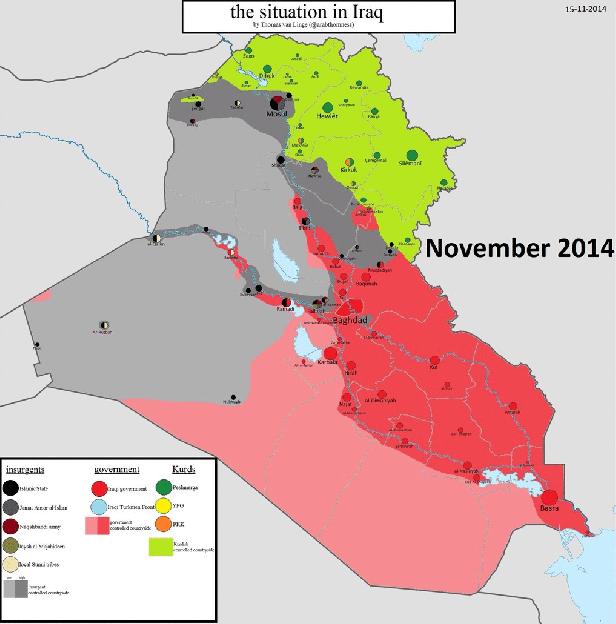One of the central arguments advanced by opponents of the United Kingdom’s decision to extend its air war against the so-called Islamic State (ISIS) from Iraq into Syria is that it will not work at best or at worst will be counterproductive. As senior lecturer at the prestigious School of Oriental and African Studies Adam Hanieh in his revisionist history of ISIS put it:
“Western military intervention in the region will only provide further sustenance for the organization. Precisely because war and occupation have laid such a fertile ground for Islamic State to grow, it is patently obvious that this kind of response will only worsen the situation.”
This argument resonates with much of the public only because of widespread ignorance of what is actually going on on the ground in Iraq and Syria. The fact of the matter is that the U.S.-led air campaign to degrade and destroy ISIS is working and there is not a shred of hard, circumstantial, or anecdotal evidence that the U.S.-led airstrike campaign is making the ISIS problem worse.
Anyone capable of reading a map can see this for themselves.


The above maps of Iraq and Syria show that ISIS has lost a significant amount of territory since the U.S.-led air campaign began in the fall of 2014. Since then, ISIS has only won two military victories — one in Syria at Palmyra since the U.S. refused to act as Assad’s air force and ISIS was able to cross the Homs desert unscathed to seize the city and one in Iraq at Ramadi — and has suffered many defeats, at Kobanî at the hands of the Syrian-Kurdish People’s Protection Units (YPG), at Tikrit at the hands of Iranian-backed Iraqi Shia militias, and most recently at Sinjar by the Iraqi-Kurdish peshmerga. In fact, the leftist YPG have cleared all but one area of the Turkish border of ISIS’s presence with the help of U.S. airstrikes and supplies.
These battlefield reversals simply would not have occurred if ISIS had been strengthened as a result of the U.S.-led air campaign. ISIS’s media output would not be falling, civilians living in ISIS-held areas and white-collar workers staffing ISIS’s infrastructure facilities would not be fleeing, and ISIS fighters would not be defecting if the U.S.-led bombing campaign were strengthening the group. ISIS would not be ordering its fascist death squads in Europe and the U.S. to launch terrorist attacks if the U.S.-led campaign against them in Iraq and Syria were making them stronger and not weaker. Not one of the Paris attackers nor the San Bernardino shooters were ‘radicalized‘ by or joined ISIS after the beginning of the airstrike campaign in late 2014. The bombing campaign has led to no groundswell of popular support for the organization either in its home base of Iraq or ISIS-occupied Syria.
There are sound internationalist reasons to oppose the United Kingdom’s extension of airstrikes from Iraq into Syria but those reasons have to do with broader Syria policy contradictions and not with whether hitting ISIS from the air in tandem with popular forces fighting on the ground can destroy the group. Indeed, that combination is how ISIS’s predecessor, Al-Qaeda in Mesopotamia, was nearly eradicated once before.

“Indeed, that combination is how ISIS’s predecessor, Al-Qaeda in Mesopotamia, was nearly eradicated once before.”
Alongside a fairly robust, boots-on-the-ground COIN effort by the US and its allies.
Fairly pertinent little bit you omitted there.
LikeLike
True but in my defense the U.K. parliament debate that precipitated this piece was not about putting ground troops in Syria and frankly those boots should have never been there in the first place i.e. Iraq should not have been invaded to begin with.
Do you think it is wise to put U.S./U.K. should puts tens or hundreds of thousands of troops into Syria to re-create the “fairly robust, boots-on-the-ground COIN effort” you are referring to? I don’t, but perhaps we disagree.
LikeLike
I think the main problem is that ISIS has spread to various countries in the Middle East, including Libya, Afghanistan, and Yemen. That being said, you are most definitely correct to point that ISIS has lost significant ground in Iraq and Syria and the counteroffensive there is working, although much slower than many would like.
LikeLike
You’re absolutely right that ISIS’s spread to many countries is a major problem, but I tend to think that if they are defeated on their home turf their appeal to would-be jihadists will take a big hit because none of their new affiliates is a self-contained economically viable proto-state … yet. I also agree progress against ISIS’s home base is too slow but since the Obama administration continues to do as little as possible as late as possible with regards to Syria it will be the next administration that will have to finish ISIS off.
LikeLiked by 2 people